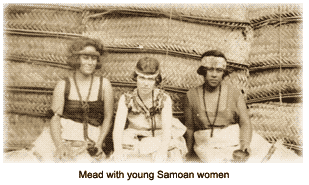Margaret Mead was a celebrated American anthropologist whose personality and outspokenness, along with the quality of her scientific work, were factors that earned her notoriety.
Beginnings
Mead was born on December 16, 1901, in Philadelphia, Pennsylvania. Her father was a professor, and her mother was a social activist. While Margaret was growing up, her family moved often. Her experiences from living in many different areas profoundly shaped her perspective on the world.
Margaret attended numerous schools. Following high school, she entered DePauw University in Indiana in 1919. She transferred to Barnard College in New York City a year later. Margaret graduated from Barnard in 1923, and entered the graduate school of Columbia University where she was greatly influenced by anthropologists Franz Boas and Ruth Benedict.
Margaret received an M.A. in psychology in 1924. In 1925, she traveled to the South Seas to do some field work for her doctorate. She also gathered material for her first book, Coming of Age in Samoa, which was published in 1928. It was a long-term best-seller and showed her characteristic reliance on observation as opposed to statistics for her data. Mead received her Ph.D. in anthropology in 1929.
 Professional life
In 1926, Mead joined the American Museum of Natural History in New York City as assistant curator, serving until 1942, then as associate curator from 1942 to 1964. She was the curator of ethnology from 1964 to 1969, and became curator emeritus from 1969 to 1978. In addition, Mead taught at Columbia as an adjunct professor, beginning in 1954.
As an anthropologist, Mead was known for her studies of the nonliterate people of the South Seas. She was especially interested in various aspects of their mindset and culture, along with the cultural conditioning of sexual behavior.
Mead traveled to the South Seas on numerous occasions. That resulted in several books, including Growing Up in New Guinea, published in 1930; and Sex and Temperament in Three Primitive Societies (1935). The latter study contributed the women’s liberation movement, since it claimed that females are dominant in the Tchambuli tribe in Papua, New Guinea. She also co-authored Balinese Character: A Photographic Analysis in 1942, with Gregory Bateson, her husband at the time.
Some of her later works include Male and Female: A Study of the Sexes in a Changing World (1949), Anthropology: A Human Science (1964), Ruth Benedict (1974), a biography of her friend Ruth; and an autobiography of her early years, Blackberry Winter, in 1972.
Private and public lives
Mead was married three times, first to a minister, Luther Cressman, in 1923; they divorced in 1926. Her second marriage was to fellow anthropologist Reo Fortune in 1928; they divorced in 1934. She then married Gregory Bateson in 1936, also a anthropologist. Margaret and Gregory tried to have children. After suffering several miscarriages, Margaret gave birth to their daughter, Mary Catherine Bateson, who also became an anthropologist. Margaret and Gregory divorced in 1946.
As a celebrity, Mead was known for her frequently controversial comments on women’s rights, childbearing practices, sexual morality, drug abuse, environmental pollution, and world hunger.
Professional life
In 1926, Mead joined the American Museum of Natural History in New York City as assistant curator, serving until 1942, then as associate curator from 1942 to 1964. She was the curator of ethnology from 1964 to 1969, and became curator emeritus from 1969 to 1978. In addition, Mead taught at Columbia as an adjunct professor, beginning in 1954.
As an anthropologist, Mead was known for her studies of the nonliterate people of the South Seas. She was especially interested in various aspects of their mindset and culture, along with the cultural conditioning of sexual behavior.
Mead traveled to the South Seas on numerous occasions. That resulted in several books, including Growing Up in New Guinea, published in 1930; and Sex and Temperament in Three Primitive Societies (1935). The latter study contributed the women’s liberation movement, since it claimed that females are dominant in the Tchambuli tribe in Papua, New Guinea. She also co-authored Balinese Character: A Photographic Analysis in 1942, with Gregory Bateson, her husband at the time.
Some of her later works include Male and Female: A Study of the Sexes in a Changing World (1949), Anthropology: A Human Science (1964), Ruth Benedict (1974), a biography of her friend Ruth; and an autobiography of her early years, Blackberry Winter, in 1972.
Private and public lives
Mead was married three times, first to a minister, Luther Cressman, in 1923; they divorced in 1926. Her second marriage was to fellow anthropologist Reo Fortune in 1928; they divorced in 1934. She then married Gregory Bateson in 1936, also a anthropologist. Margaret and Gregory tried to have children. After suffering several miscarriages, Margaret gave birth to their daughter, Mary Catherine Bateson, who also became an anthropologist. Margaret and Gregory divorced in 1946.
As a celebrity, Mead was known for her frequently controversial comments on women’s rights, childbearing practices, sexual morality, drug abuse, environmental pollution, and world hunger.
The end, and after Margaret Mead died on November 15, 1978, in New York City, at the age of 76. She had lived a successful and productive life. Mead was honored with a number of awards in her life, and posthumously. She was inducted into the National Women's Hall of Fame in 1976. In 1979, she was awarded the Presidential Medal of Freedom. Mead also was featured on a commemorative stamp in 1998. Margaret Mead was a clear and forceful thinker who exerted a great impact on the fields of anthropology and psychology.